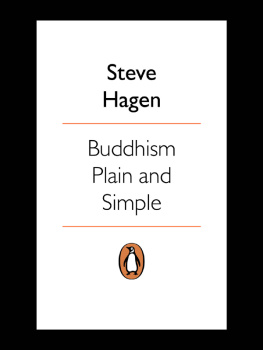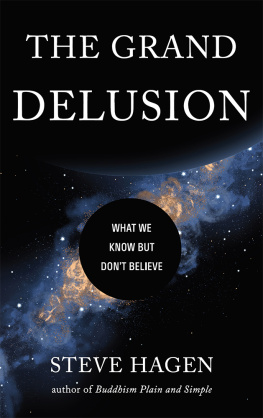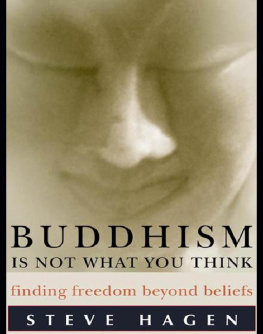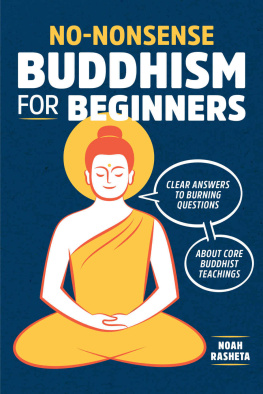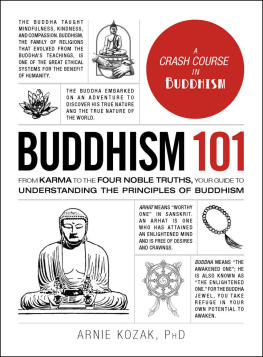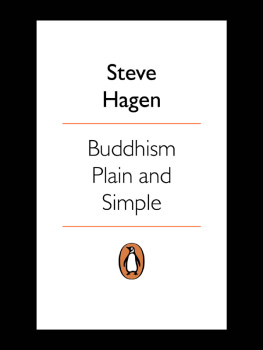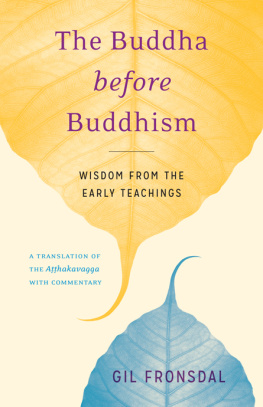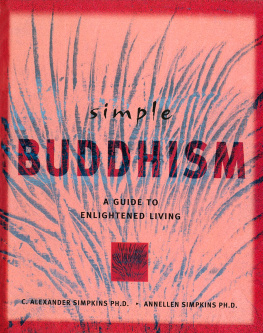Steve Hagen - Buddhism Plain and Simple
Here you can read online Steve Hagen - Buddhism Plain and Simple full text of the book (entire story) in english for free. Download pdf and epub, get meaning, cover and reviews about this ebook. year: 1999, publisher: Penguin; New Ed edition, genre: Religion. Description of the work, (preface) as well as reviews are available. Best literature library LitArk.com created for fans of good reading and offers a wide selection of genres:
Romance novel
Science fiction
Adventure
Detective
Science
History
Home and family
Prose
Art
Politics
Computer
Non-fiction
Religion
Business
Children
Humor
Choose a favorite category and find really read worthwhile books. Enjoy immersion in the world of imagination, feel the emotions of the characters or learn something new for yourself, make an fascinating discovery.
- Book:Buddhism Plain and Simple
- Author:
- Publisher:Penguin; New Ed edition
- Genre:
- Year:1999
- Rating:5 / 5
- Favourites:Add to favourites
- Your mark:
- 100
- 1
- 2
- 3
- 4
- 5
Buddhism Plain and Simple: summary, description and annotation
We offer to read an annotation, description, summary or preface (depends on what the author of the book "Buddhism Plain and Simple" wrote himself). If you haven't found the necessary information about the book — write in the comments, we will try to find it.
Buddhism Plain and Simple — read online for free the complete book (whole text) full work
Below is the text of the book, divided by pages. System saving the place of the last page read, allows you to conveniently read the book "Buddhism Plain and Simple" online for free, without having to search again every time where you left off. Put a bookmark, and you can go to the page where you finished reading at any time.
Font size:
Interval:
Bookmark:


PENGUIN BOOKS
PENGUIN BOOKS
Steve Hagen is a Zen priest, a long-time teacher of Buddhism and the author of How the World Can be the Way It Is.
He began studying Buddhism in 1967, and in 1975 became a student of Zen master Dainin Katagiri, the author of Returning to Silence: ZenPractice in Daily Life. He was ordained a Zen priest in 1979. Hagen later studied with a number of other teachers in Asia and Europe. In 1989 he received Dharma Transmission (endorsement to teach) from Katagiri Roshi.
Steve Hagen lives in Minneapolis, where he lectures, teaches meditation, and leads retreats at the Dharma Field Meditation and Learning Center. He is currently working on several books and has recently edited You Have toSay Something (Shambhala 1998), a collection of Dharma talks by Katagiri Roshi.
With gratitude I dedicate this book to all beings.
A S THE CURRENT MILLENNIUM COMES TO a close, most of us have lost faith in our ancient storybook versions of the world. With the development of science, many of us have come to see the universe as an inconceivably strange, vast, complex, impersonal, multi-dimensional, and perhaps meaningless realm of mind and matter.
We may feel forced to deal with this loss of faith by going to one of two wretched extremes. Either we blind ourselves to our predicament and attempt to escape via drugs or alcohol or our careers or any of innumerable belief systems, or we face the woeful prospect that were intelligent creatures living in a meaningless world.
Many of us act as though we could find fulfillment if only we possessed enough money, enough security, enough respect, enough love, enough faith, enough education, enough power, enough peace, enough knowledge, enough something.
There are others among us, however, who dont (or cant) buy into this. They sense that real security is impossible to attain. For they know that even if we could manage to accumulate all we desire, it will be inevitably taken from us by death. Our mortality looms above us, as terrifying as it is certain. We seem utterly stumped. How can we possibly find peace under these conditions?
Not only do we feel imprisoned by our ignorance, we seem doomed to remain that way. As Yang Chu, the fourth century b.c.e. Chinese philosopher put it:
We move through the world in a narrow groove, preoccupied with the petty things we see and hear, brooding over our prejudices, passing by the joys of life without even knowing that we have missed anything. Never for a moment do we taste the heady wine of freedom. We are as truly imprisoned as if we lay at the bottom of a dungeon, heaped with chains.
What is the basic human problem that no apparent remedy will cure? What is our existence all about? How can we ever possibly comprehend the whole of it? And yet isnt knowledge of the Wholeknowledge thats not relative, or dependent on changing conditionsprecisely what would be required to free us from the doubts and dilemmas that cause us so much pain and anxiety?
We long to be free from our confusion and discontent, not to have to live out our lives chained helplessly to uncertainty and fear. Yet we often do not realize that its precisely our confused state of mind that binds us.
There is a way to move beyond this ignorance, pessimism, and confusion, and to experiencerather than comprehendReality as a Whole. This experience is not based on any conception or belief; it is direct perception itself. Its seeing before signs appear, before ideas sprout, before falling into thought.
Its called enlightenment. Its nothing more or less than seeing things as they are rather than as we wish or believe them to be.
This liberation of mindthis direct awareness of Reality as a Wholeis fully accessible to anyone willing to attend to their actual experience.
Twenty-five hundred years ago in India a man named Gautama experienced this liberation. He devoted the remainder of his life to teaching others how to experience the same freedom of mind. After he awakened from the crippling ignorance that kept him from knowing what was actually going on, he became known as the Buddhathe awakened one.

When the Buddha was asked to sum up his teaching in a single word, he said, awareness. This is a book about awareness. Not awareness of something in particular, but awareness itselfbeing awake, alert, in touch with what is actually happening. Its about examining and exploring the most basic questions of life. Its about relying on the immediate experience of this present moment. Its not about belief, doctrine, formula, or tradition. Its about freedom of mind.
The Buddha learned to see directly into the nature of experience. As a result of his teaching and his life, a new religion arose and spread throughout the world. In the process, like all religions, Buddhism accumulated (and generated) a variety of beliefs, rituals, ceremonies, and practices. As it spread from country to country, it acquired a wide variety of cultural trappings: special clothes and hats, statues, incense, gongs, bells, whistleseven peculiar architectural forms, icons, and symbols. This book leaves all that behind.
Rituals, ceremonies, prayers, and special outfits are inevitable, but they do notthey cannotexpress the heart of what the Buddha taught. In fact, all too often, such things get in the way. They veil the simple wisdom of the Buddhas words, and distract us from it.
This is a major problem, and not just for those of us raised in the West. It is not easy to know where Buddhism ends and Asian culture begins, or to distinguish the original and authentic teachings of the Buddha from what was added later by people with less acute insight. As a result, many Americans and Europeans genuinely believe that Buddhism is about worshipping Buddha, or bowing and wearing robes, or working oneself into a trance, or coming up with answers to bewildering riddles, or past and future incarnations.
Buddhism is not about these beliefs and practices. The observations and insights of the Buddha are plain, practical, and eminently down-to-earth. They deal exclusively with here and now, not with theory, speculation, or belief in some far-off time or place. Because these teachings remain focused on this momenteven as you read thisthey remain relevant, and of profound value, to every culture and every person who investigates them seriously. It is to these uncluttered, original insights and observations that this book returns.
This book is divided into three parts. In Part One, well focus on the primary teachings of the Buddha, which he called the four truths of existence. In Part Two, well focus in greater detail on the fourth of these truths. Here the Buddha lays out a patha practical and effective way of lifeby which we can understand and deal with the world as we find it. And in Part Three, well look more closely still to magnify the first two aspects of this path. These two aspects comprise the wisdom teachings of the Buddha, those that deal with human intent and awareness.
For people investigating Buddhism for the first time, Buddhism Plain and Simple offers a clear, straightforward look at the wisdom and guidance of an enlightened teacher who lived some 2500 years ago but whose teachings remain as vital and penetrating today as ever. For people already familiar with Buddhism, including long-time practitioners, this book provides a long-needed overview of Buddhisms essentials, free of the fetters and cultural trappings that have accumulated over twenty-five centuries. For every person with a desire to see deeply into the nature of existence, it is a call to awakening.
Font size:
Interval:
Bookmark:
Similar books «Buddhism Plain and Simple»
Look at similar books to Buddhism Plain and Simple. We have selected literature similar in name and meaning in the hope of providing readers with more options to find new, interesting, not yet read works.
Discussion, reviews of the book Buddhism Plain and Simple and just readers' own opinions. Leave your comments, write what you think about the work, its meaning or the main characters. Specify what exactly you liked and what you didn't like, and why you think so.

